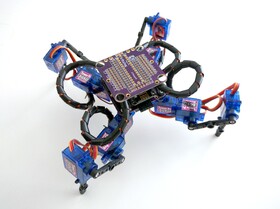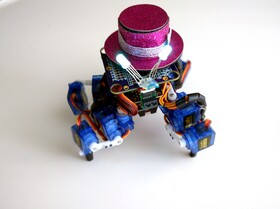SpiderWing¶
Spider robot powered by Adafruit Feather boards and CircuitPython.
This is the successor of the Tote robot, and its small family ( Tote Zero , Tote HaD , D1 Mini Tote ). Tote itself was focused mostly on affordability, ease of assembly and extensibility — and I think that it achieved those goals relatively well. However, it turns out that physically building the robot and programming the first gait is just the tip of the iceberg. We need something a little more powerful than a simple Arduino, and something much easier to program and test. The SpiderWing builds on top of Tote, but focuses more on the ease of programming and reliability. It uses slightly more expensive parts (Adafruit Feather boards, SG92R servos) to be more reliable and easier to reproduce exactly (whereas every Tote is slightly different from all the others). It will also use advanced sensors, such as the time-of-flight distance sensors or the IMU sensors with built-in fusion algorithms, in order to get better and more consistent results.
Of course the ultimate goal remains the same — to bring walking robots into our homes and hopefully crowd-source their development, so that they become reliable and cheap enough to be generally useful.
Logs¶
2019-12-31 - It’s Alive (Again)
2019-12-16 - Bodgetty Bodge
2019-12-08 - Batteries! Why Doesn’t Anybody Think About the Batteries?
2019-11-03 - New PCB Design
2019-11-02 - Time for a Refresh
2017-07-23 - Repository and License
2017-07-23 - Proper Crawl
2017-07-19 - Status Update
2017-05-15 - Smartening Up
2017-05-14 - Sensor and Cable Management
2017-05-13 - The Good, The Bad and the Adorable
Links¶
Components¶
Component |
Count |
Notes |
|---|---|---|
Adafruit Feather supporting CircuitPython |
1 |
|
3.7V 1S LiPO battery |
1 |
|
SPDT switch |
1 |
|
SG92R Microservo |
12 |
|
M1.2x4 screws |
24 |
|
male pin headers |
6 |
|
female pin headers |
2 |
|
battery holder |
1 |
|
PCA9685 chip |
1 |
|
4.7kΩ 0805 resistor |
2 |
Instructions¶
Mechanical Assembly¶
For mechanical assembly, follow the instructions at http://tote.readthedocs.io/en/latest/assembly_v5.html#legs
Electronics¶
Solder the headers, the PWM chip and the two resistors onto the PCB. Add the power switch and the battery holder.
Programming¶
Copy the python files from the project’s repository onto your feather board.
PROFIT!¶
Modify the code, add sensors, experiment.
 deshipu.art
deshipu.art

